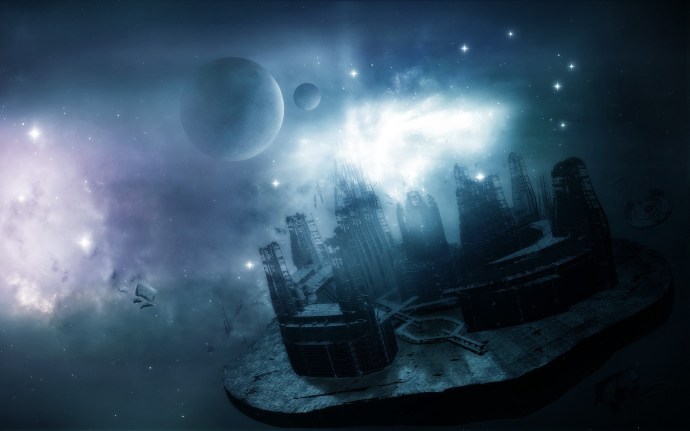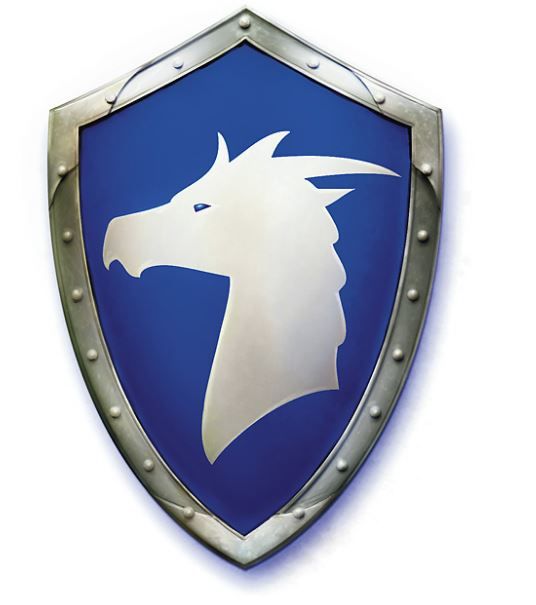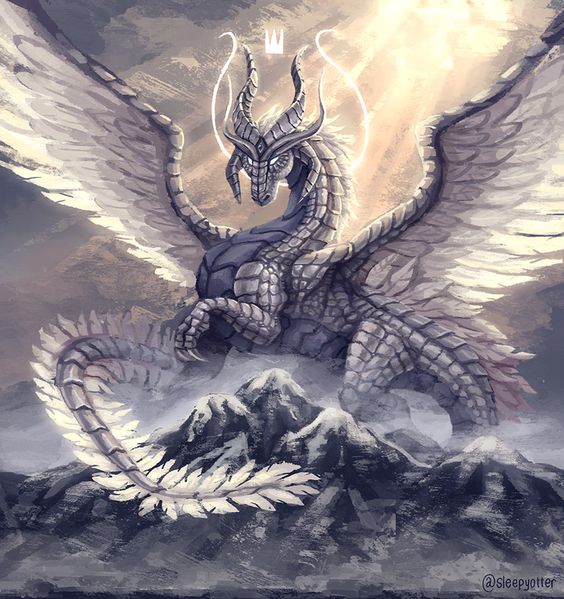Bahamut
Commandments of the Platinum Dragon;Bahamut was the dragon god of justice and a subservient deity to Torm, god of law. Before entering the Faerûnian pantheon, he was a member of the Draconic pantheon, as a deity of good dragons, metallic dragons, wisdom, and enlightened justice (justice tempered with mercy and punishment with forgiveness) known by the name of Xymor. For some time, he was also a member of the Untheric pantheon, under the alias of Marduk. His natural form was that of a platinum dragon, said by many to be the only one of his kind. He was also the eternal rival of his sister Tiamat, queen of the chromatic dragons.
- Stand as a paragon of honour and justice.
- Smite evil wherever it is found, yet show compassion to those who have strayed from righteousness.
- Defend the weak, bring freedom to the persecuted, and protect the ideals of justice and order.
Appearance
In his natural form, Bahamut was a massive dragon approximately 180 ft (55 m), with a tail the same length as his body, with platinum scales tougher than any shield (said by some to be virtually indestructible) that glowed with a faint blue sheen, and blue eyes, the exact color of which was hard to specify and may have depended on Bahamut's mood. As Xymor, he was described as a huge dragon wrapped in a scintillating aura of light so brilliant that it was impossible to tell his colour.When he wished to wander the mortal world, he usually took the appearance of an old human or demihuman wizard dressed in peasant robes accompanied by seven canaries or other songbirds. This persona came to be known among mortals as Fizban the Fabulous. Some sages believed Bahamut used this humanoid guise to not frighten non-dragon beings. They also believed that while Bahamut was fond of his old man guise, he had other guises as well. Other recorded guises included that of a prince with a carriage drawn by seven horses, an urchin accompanied by seven friends, a beggar followed by seven dogs, a humble fisher or a young monk who bear the title of the "Grandmaster of Flowers", a title that was also used by the monks of the Monastery of the Yellow Rose.
Personality
Bahamut was stern and very disapproving of evil, always arguing with Asgorath about his crusade against it. He accepted no excuses for evil acts, and didn't tolerate even minor offenses by evil creatures.In spite of his stance, he was also considered one of the most compassionate beings in the multiverse. He had limitless empathy for the downtrodden, the dispossessed, and the helpless. He usually preferred to polymorph those who had offended him instead of killing them, although it was also said that Bahamut loathed to sully himself with the blood of evil creatures. By draconic standards, Bahamut was neither vain nor desirous of treasure. He valued wisdom, knowledge, prophecies, and songs instead. He used the great wealth he had amassed over the ages to help those in need, while using the magic items he had gathered to further his goals. However, he also pursued viciously (usually sending his champions and followers) those who tried to steal the hoard from his palace as, after all, he was a god of justice. Bahamut also liked to prove the strength and worthiness of his followers by battling against them in his dragon form, halting the combat when his followers were injured or when they overcame him. However, he was prone to get carried away by his zeal, and had powerful healers on hand in case he had gravely injured one of his followers in those battles.
While his court comprised only gold dragons, Bahamut enjoyed the company of all good dragons, delighting in their differences and varied personalities.
Powers
Bahamut disdained combat, and he preferred to talk with his opponents and convince them to surrender using his legendary diplomatic skills. Bahamut spoke many languages, including Draconic, Celestial, Auran, and Common, although he had the ability to speak to any intelligent creature thanks to his ever-present, receptive form of telepathy. Despite his aversion to battle, he was easily capable of defending himself. Along with all the standard powers and godly senses of a deity of his rank, as well as the natural abilities of an ancient dragon, those who saw him fight claimed that he had two breath weapons, one a powerful cone of cold, the other a vapor that turned his enemies into gaseous forms. A third special attack was his roar, which was so powerful that it could disintegrate creatures or objects within 100 feet (30 meters). If facing off against more powerful creatures, this roar would still permanently deafen those who weren't turned to dust. He was also capable of breathing the holy winds of Mount Celestia, which allowed him to heal his allies and even resurrect his fallen comrades. On top of that he was more powerful than any mortal dragon, and was also reputed to know every arcane and divine spell. Few things in the mortal world could cause him lasting harm.Also, Bahamut had the ability to see invisible beings and objects, and to breathe underwater indefinitely. Likewise, he could freely use his breath weapons or cast spells while underwater.
Aspects
Bahamut was able to create aspects of himself from the willing sacrifice of a powerful metallic dragon worshiper. While the dragon died during the ritual, the newly created aspect remembered all of its previous life and was utterly bound to Bahamut's will forever after. However, unlike normal divine aspects of other gods, aspects of Bahamut were not extensions of Bahamut's self but rather independent beings. They were not as powerful as Bahamut's normal avatars, however.Bahamut disliked creating aspects in this way, as he preferred that his dragon worshipers remained as dragons rather than sacrifice themselves, but he sometimes asked one of his dragon worshipers to become an aspect when it was needed, to act as an emissary, to become a long-term guardian, or to chase evil beings way too powerful for his mortal followers to face. Bahamut was also willing to create aspects if a worshiper performed a great sacrifice, such as offering their own life or a great treasure.
Occasionally, aspects of Bahamut arose spontaneously on Celestia or a closely related plane. Unlike Bahamut's normal aspects, these spontaneous aspects were short-lived, biological echoes of Bahamut's divine will. These aspects usually faded to nothingness within a day. These aspects were usually the ones who answered the magical summons of Bahamut's worshipers.
According to some sages, aspects of Bahamut physically combined elements of all kinds of metallic dragons, and were big enough to tower even the greatest of the mortal ancient dragons. Aspects of Bahamut were fearless, surprisingly intelligent combatants who cared nothing for their continued existence, something that made them far more dangerous than mortal dragons because of their coldly calculated rage and battle acumen. Aspects of Bahamut usually fought to the death unless their existence was more important than any tactical gain they could get from a battle. Despite this, aspects of Bahamut were more willing to converse with mortals and deal diplomatically with them than most divine aspects, though they only spoke from positions of superiority due to them as representatives of the Platinum Dragon.
Divine Domains
Life, War
Divine Classification
Greater God
Alignment
Lawful Good
Current Location
Realm
Church/Cult
Children
Sex
Male
Gender
Male
Presentation
Masculine
Eyes
Golden Hue
Belief/Deity
Draconic Pantheon
Ruled Locations
The Crown of Seven Wyrms
Crown of Seven Wyrms Properties: Each of the seven pieces of this crown is a circlet artifact that resizes itself to the head of a wearer attuned to it. The helical shapes of each metal circlet can be combined with the others to create a more ornate crown, when combined the circlets count as a single magic item for the purposes of attunement. Adding two or more circlets together unlocks additional beneficial effects that build until all seven are combined the create the complete Crown of Seven Wyrms. Along with the power of each individual circlet, you gain benefits in the following order, and the number of them gained is equal to the number of circlets that you have combined:Damage Absorption. You have resistance against the circlet's damage type. If you already have resistance to that damage type from another source, you instead have immunity to that damage type. If you already have immunity to that damage type from another source, whenever you are subjected to damage of that type, you take none of that damage and regain a number of hit points equal to half the damage dealt of that type.
Dragon Breath. You gain a breath weapon that functions the same as that of a dragonborn. The damage type dealt matches that of the circlet. When multiple circlets are combined together, you gain one use of each per short rest. If you have your own natural breath weapon that requires rest to recharge, it gains a recharge of 6.
Draconic Majesty. While you are wearing no armor, you can add your Charisma bonus to your Armor Class.
Dragon Sight. You gain darkvision out to 60 feet, or to an additional 60 feet if you already have that sense. Once per day, you can gain truesight out to 30 feet for 5 minutes.
Dragon Tongue. You can speak and understand Draconic. You also have advantage on any Charisma check you make against chromatic dragons.
Legendary Resistance (1/Day). If you fail a saving throw, you can choose to succeed instead.
Healing. You can use your reaction to regain hit points equal to 10 + your Charisma modifier.






Comments